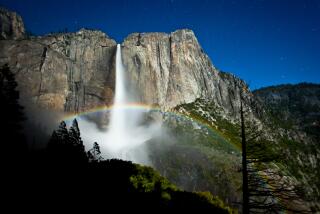Autumn Glory : Changing Season Brings Breath-Taking Optical Phenomena
- Share via
The season of color is upon us. You see it in the leaves of sycamores and liquidambar trees, in pumpkins ready for harvest, and in the sky overhead.
Dry Santa Ana winds rake the North County now and again, bringing in impossibly blue daytime skies, and warm, black, star-peppered nights. Summer’s muggy air, hazy skies, and tiresome night-and-morning gray clouds will soon be forgotten.
With clearer, drier air to look through, sunsets and sunrises really blaze brightly these days. After the sun goes down, the western sky cycles through a sequence of odd pink, orange, crimson and blue-gray hues. The opposite sequence takes place in the eastern sky at sunrise. The unusually vivid hues are largely a consequence of Mt. Pinatubo’s eruption more than a year ago. A small fraction of the volcano’s atomized remnants haven’t yet had time to settle out of the stratosphere, and these tiny particles are still capable of scattering sunlight.
Whatever moisture does manage to come our way this time of year tends to settle at very low or very high altitudes. Often in the late evening, the cool, humid breath of the sea slides inland over the night-chilled coastal plain, and a blanket of ground-hugging fog materializes.
Five or 6 miles up, just under the stratosphere, moisture jells into cirrus clouds--filmy, wispy or mottled puffs of white--that dance and metamorphose in slow motion overhead. Seldom (at least not until December) does the cirrus build into lower, thicker clouds bearing raindrops big enough to fall on the parched landscape below.
Both high-floating cirrus clouds and low fog are responsible for optical effects ranging from common to startling. From now through winter, keep a close eye on the ever-changing skies. You may witness one or more of the following interesting, and sometimes spectacular, optical phenomena:
22 ice-crystal halos
Nearly everyone sees the perfectly round rings, or halos, that can form around the sun, or a bright moon. Despite their rainbow-like quality (some have colored fringes on the inside and outside edges), they have nothing to do with rainbows. A rainbow is essentially light interacting with water droplets in clouds or rain, while halos are caused by sparkles of sunlight (or moonlight) in billions or trillions of tiny ice crystals belonging to high clouds. You must face the sun to see a halo, while rainbows are centered on a point opposite the sun. Halos are quite small (more sharply curved) compared to rainbows, subtending a radius of only 22. The bright, primary bow of a rainbow has a radius (centered around the observer’s shadow) measuring 42.
The 22 halos are commonly seen whenever cirrus clouds lie in the direction of the sun or moon. Such clouds always consist of tiny, hexagonal ice crystals that behave somewhat like simple prisms do, refracting light from a point of origin (like the sun) through an angle of 22. The ice crystals tend to be randomly oriented within such clouds, so the halo tends to be about the same brightness all the way around, provided the clouds aren’t patchy.
Sun dogs (a.k.a. mock suns, false suns) look like small, rainbow-like spots bracketing the sun left and right, typically when the sun is close to the horizon. These are explained as a modification of the 22 ice-crystal halo phenomenon for crystals that are not randomly oriented. Sometimes, sun dogs and a 22 halo will appear at the same time, the sun dogs being attached to the left and right sides of the halo.
On rare occasions, around the time of sunset or sunrise (frequently when the sun is just below the horizon), you my see a sun pillar--a vertical shaft of light floating amid thin, high clouds above the sun’s position. Simple reflection of light explains why the pillar exists: You see the sparkles of sunlight on the undersides of countless flat plate-like ice crystals. In cirrus clouds having little turbulence (cirrostratus clouds), the mirror-like crystals drift horizontally and act like tiny mirrors that reflect the sun’s light.
The glory
A mix of dense fog and sunshine sets the stage for one of Nature’s most mysterious and little-known wonders: the “specter of the Brocken” or “glory.” The former name comes from a mountain peak in central Germany, where the effect is commonly seen. Some who have witnessed the glory have attributed it to supernatural causes. The physics behind the phenomenon, however, is well understood.
To see the glory purposefully--not just accidentally--start hunting for it at sunrise on a foggy day. Late October through December mornings are often perfect for this, as long as you are near the coast. Drive or walk to a place where you can either get just above or right next to a sharply defined fog bank. Try to maneuver yourself so that the shadow cast by your body--directly opposite the rising sun--falls upon the fog, preferably about 100 feet to 300 feet away. Look for concentric rings of blue and red light around the shadow of your head. The glory can be photographed, but it often appears indistinct.
Next time you fly out of Lindbergh Field on a foggy or overcast morning, look for the same effect after you punch through the clouds into the clear air above. Quite often, the moving shadow of the plane cast on the clouds below is accompanied by a glory.
More to Read
Sign up for The Wild
We’ll help you find the best places to hike, bike and run, as well as the perfect silent spots for meditation and yoga.
You may occasionally receive promotional content from the Los Angeles Times.






